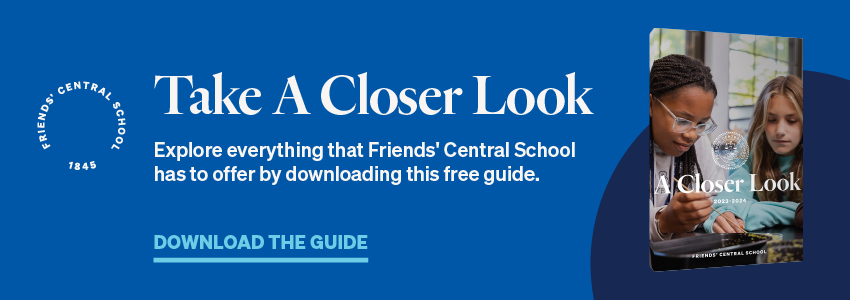 “But all my friends get to do it.”
“But all my friends get to do it.”
“Why can’t I do that too?”
If these refrains sound familiar, you are likely a parent. This battle between parents working to make the best possible decisions for their children, and their children’s idea of what is “right” or “fair”—especially when their friends and peers are modeling different behavior—is never-ending and can be incredibly frustrating.
But with the emergence of the global Coronavirus pandemic (COVID-19) and the rapid changes that it’s brought to society, strong parental leadership is more critical than ever. Specifically, parents can play an important role in ensuring that their families practice social distancing in order to slow the spread of the disease and flatten the curve of infections threatening the healthcare system.
Take a closer look at Friends' Central School by Downloading our brochure
You may be wondering, though: How can you ensure your children understand the necessity of staying socially distant, especially in the face of so many other families with different ways of handling this new reality?
The answer, it seems, lies in helping your children understand how their actions affect the world around them, especially within their immediate community. Instilling this sense of social responsibility in kids isn’t always easy, but reinforcing their place in this world, and their role in keeping those around them safe, will help parents win the social distancing argument—even at the expense of birthday parties, play dates, vacations, and time at the playground.
How to Talk to Kids and Teens About Social Distancing
With the outbreak of this Coronavirus, we are all—adult and child alike—facing an event the likes of which we’ve never seen before.
Because we have no frame of reference or prior experience to draw on, all of our information comes from listening carefully to the experts and heeding the advice and directions of those who are leading us, all hoping to get through this pandemic safely.
At times, the information can seem overwhelming and too frightening to convey to our children. For this reason, some parents might think the best tactic is to try to keep the world outside the walls of their homes away from their children. After all, isn’t the ultimate job of a parent to protect their children?
However well intentioned, this tactic can actually do more harm than good. With this worldwide threat, keeping your children well informed is an important part of helping them understand the necessity of social distancing and isolation, and ensures you are more able to successfully protect your family, and others, in the long run.
Luckily, there are many resources available to help you communicate this situation with your children, and there are a few key elements to consider when approaching the seriousness and importance of the roles they need to play.
1. Be honest and age-appropriate.
It can be difficult to know exactly how much you should share with your children. An easy guideline is that the information you do communicate needs to depend largely on your child’s age and their ability to comprehend the situation.
Naturally, older children will have more of an idea of what is going on, as they are exposed to a constant stream of updates on the television, internet, and from their peers. This makes honest, open conversation about current events easier to accomplish. You’ll need to help your older children separate rumor from fact and help them understand what the leaders in their community are doing to help keep them safe.
For younger children, who aren’t exposed to these outside influences, it might seem easier to shelter them from the information entirely. But as the levels of stress, anxiety, and most importantly—disruption of routine—rise in your household, even the youngest members of the family may respond to these changes with fear and uncertainty. For this reason, it’s important to be as open and honest with your little ones as possible and help them understand what is going on.
Any explanation of the situation should be approached with a sense of calm and compassion. Little ones are likely to be frightened, and it will help to have parents focus more on the simple (and very common to them) ways they can help stay safe.
Parents can focus on things like hand-washing and proper coughing and sneezing techniques that families should be practicing all year round. Little ones who understand how these actions keep themselves and their loved ones safe will feel more in control, and more able to mentally and emotionally weather the storm.
2. Rely on accurate resources.
The single most important factor to consider when approaching the Coronavirus topic with your children—or any topic related to health—is to ensure you are relying on accurate resources for your information. This ensures you will be spreading knowledge, rather than fear.
Luckily, there are many, many great resources for parents to turn to for information, including videos and cartoons specifically designed to teach children about germs. While they don’t focus on the Coronavirus, the lessons in them certainly apply to this situation. Some of our favorites include:
- PBS For Kids: This is perfect for younger children. The videos in this list all feature characters that your children likely know and love as (like Daniel Tiger, Curious George, and the Muppets from Sesame Street) they learn about germs and good hygiene practices.
- Brains On!: This popular podcast channel aimed at teaching children about science in a fun and accessible way recently dedicated an entire episode to teaching kids about the pandemic.
- NPR: For children who are a bit older, this graphic-novel-inspired comic strip published by NPR can be a great way of sharing just enough details about the pandemic without causing fear.
- Infographics: For older children and teens who can handle specifics and data about the pandemic, there are a lot of great infographics, charts, and diagrams that really aim to drive home just why social distancing matters. The Math Behind Social Distancing is a great example.
And for parents, organizations like the National Association of School Psychologists (NASP) provide guidance on how to discuss the changes and challenges that come with the reality of a global pandemic. They discuss communication techniques, symptom identification, and stress the importance of managing mental health effects of this new routine.
On the local level, parents in the Philadelphia area might find the resources below helpful:- Patch has pulled together a number of helpful lists and guides that you might find helpful, including: Stay-At-Home Survival Guide In America: Food Delivery And More, The Coronavirus Dictionary: Social Distancing, Flatten The Curve, and Pals Don't Let Pals Fall For Coronavirus Hoaxes On Social Media
- The City of Philadelphia has published (and continuously updates) this page of resources about Coronavirus that parents can turn to for up-to-date information, as well as this page of updates about the extent of the disease’s spread in the city.
- The Department of Public Health also has a number of articles and guides (located here) designed to help educate citizens about the pandemic and the steps that they can take to prevent its spread.
3. Put things in perspective.
While younger children rely on us to set their schedules and direct their daily lives, teenagers and young adults are often used to more autonomy over their bodies and their lives. Because of this, teens and young adults often live with a sense of invincibility—they don’t believe that they can possibly ever be harmed.
For this reason, the key in conveying the importance of social distancing and isolation is to put this pandemic into perspective and explain it in terms they understand.
Teenagers and young adults have a narrower view of the world around than adults, which can make it difficult for them to understand how their actions affect those around them. To combat this, social distancing should be explained to them in terms of it being a necessary tactic both to protect them, and to protect others who are more vulnerable than they are.
Discuss with them those who are most vulnerable to this deadly infection—the elderly and immunocompromised. Have them connect with those in their lives who fall into those categories: Grandparents, elderly neighbors, sick friends. Allow them to reconnect (remotely!) with those most at risk during this global crisis and remind them that their small sacrifice of space and time can keep loved ones from becoming ill. It is also important to remind them that young people can also become quite sick and need hospitalization.
If your child is fortunate enough to not currently be feeling sick, remind them that even people who aren’t showing symptoms could be infected with the disease, and unknowingly spread the virus to those around them. Once they understand their social responsibility and the role they play in keeping their community safe, social isolation may seem less like a major inconvenience and more like a small sacrifice that will keep their loved ones safe in the long run.
This speaks well to the concept of stewardship—the idea that each of us is responsible for taking care of others around us—which forms a core part of our philosophy.
What To Do if They Won’t Listen
As with any unpopular directive parents give their children, there is a chance that teenagers and young adults will attempt to defy the order of social isolation.
One method you can take to ensure this time of social isolation is successful is simple; Listen to what your child is saying.
For children, being forced into social distancing will feel like they are giving up so much. Parents will need to empathize with youngsters and understand that their children are missing out on milestones that are important to them—prom, graduation, their last weeks of school, times with new friendships, and possibly blossoming relationships—and allow them to process the loss and grief that comes with that sacrifice.
We’re all in this together!
Parents also need to understand that they will need to model the same behaviors they expect of their children.
Use virtual meeting platforms to “visit” their friends and family rather than seeing them in person, and encourage your child to do the same. Cancel family vacations, gatherings and other trips, but acknowledge that the choices are disappointing and not always easy—and try to find fun alternatives that can be done at home.
Seeing that their parents and caregivers are willing to make the sacrifice will reinforce for children that social distancing and isolation are truly necessary. Remember, we all have an important role to play in flattening the curve so that we can bring this pandemic to an end!



